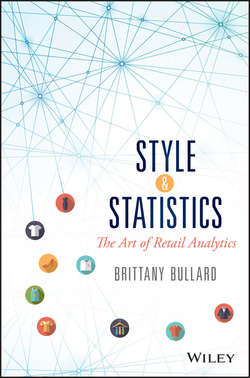Читать книгу Style and Statistics - Bullard Brittany - Страница 6
Introduction
ОглавлениеHave you ever walked into a department store and wondered how the magic of sights, smells, and staging came together? The sweet smell of gardenia wafting from the fragrance department; the eclectic assortment of pumps, sandals, and flats in the shoe department; and the eye-catching visual merchandising of in-season colors and fashions that captures the essence of time? Such is the life of a retailer, who blends art and science to create an environment where you, the shopper, take center stage.
Many major retailers started out as individually owned stores. The owners ran the store themselves. They were in the store day in and day out so they knew their business. They knew their customers and their customers’ preferences. Pricing of products was a pretty basic concept. The owners marketed by word of mouth or through local flyers and newspapers. Successful owners were able to add on more locations. As location growth increased, the complexity of buying, planning, and marketing increased. No longer were the owners in each location every day, nor did they know all of their customers on a first-name basis. With this expansion, retailers understood their customers less and were unable to tackle the workload on their own. Marketing became more difficult as well. The sheer volume of work became increasingly larger as businesses grew.
Therefore, owners began to hire a staff, who became an essential piece of the puzzle. Buyers or merchants were responsible for picking out products, determining how much to buy from different vendors, planning sales, planning inventory, and advertising their goods. The buyer had many functions in the beginning. Buyers tend to be individuals with a great eye for design. They are usually very artistic and creative individuals with good taste. Sometimes these individuals are described as being right-brained. The right side of the brain controls tasks that have to do with creativity and artistry. The right-brained, creative element for a merchant is a key benefit for selecting the perfect merchandise.
But eventually it became clear that businesses also needed a “left-brained” perspective to ensure profitability through math and logic. The left side of the brain controls tasks that have to do with logic. The left side is more geared toward math and science. Over time, the Picasso-Einstein model developed. Buyers are the Picassos, who are in charge of fashion artistry. Planners are the Einsteins, ensuring maximum profitability through math and science.
The original buyer’s role of picking products, determining how much to buy, planning sales, monitoring inventory, and managing other key metrics was divided up. Although the roles vary by retailer, in general, the planner manages the financial aspect of the business, ensuring that the sales targets are planned along with other key performance indicators and inventory. The merchant or buyer controls the selection and management of the assortment, within the financial budget that has been established by the planner. The buyer has the eye for fashion, trends, and taste. The planner ensures that the financial and strategic targets are achieved.
The greatest performance comes from a perfect marriage of the two roles. If planners were in charge of both roles, they would likely never take risks, have incredibly low inventories, and probably sacrifice presentation standards for fear of wasted inventory. Together, this partnership creates a beautiful, profitable business. The perfect marriage of art and science, it later evolved to the art and analytics of retail.
Marketing has evolved over time as well. Marketing developed from advertising. Today, advertising is a component of marketing. Advertising includes spreading the word about your brand or business. With most businesses, advertising begins as word of mouth. It can then branch out to newspaper ads, magazine ads, and even social media! Brands and retailers are now advertising on a plethora of platforms. The creation and nurturing of a retail brand is its lifeblood; think of Williams-Sonoma or Nordstrom; they both have a “brand” identity that invites and nurtures loyal customers. These brands reach their target audience through buying specific market ads to truly connect to their customers and sustain this brand loyalty.
But advertising is only one component of marketing. Marketing is the overall strategic planning, execution, and measuring of how a retailer or a brand interacts with its customers and how that brand is perceived. Public relations and community involvement aid in brand perception. Marketing is no longer thought of as a commercial or a newspaper ad. Instead, it is thought of as a lifetime relationship between a brand and a customer.
There are multiple components of a retailer’s business. These components have historically worked in silos. Merchandising and marketing, as described earlier, are two key components to driving merchandise assortments and communicating the most relevant information in the most effective way to the customer. The in-store teams, or store operations, are the components of the business that interact with the customers. The in-store teams are at the forefront of building relationships with customers once the merchandising, pricing, and marketing strategies have been executed. Last, cybersecurity is the component of the business that protects customers against cyberattacks and ensures that personal information, including credit card data, is not compromised.
The retail environment has had significant changes over the last couple of years with the rise of the digital landscape, an increase in e-commerce business, and the rise of the millennial customer. For retailers to be successful, they must break down the silos of these different components to their business to truly understand and shape the customer journey. In this book, we will walk through each component of the retailer’s business. We will discuss what each component is responsible for, how retailers are able to intertwine the components, the challenges retailers face, and how retailers can leverage analytics to overcome challenges while maintaining the art of retail to drive profitability and efficiencies.
